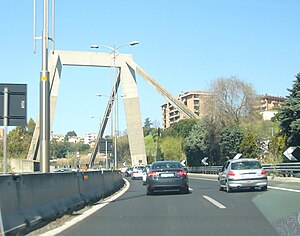Viadotto Ansa del Tevere
Coordinates: 41 ° 50 ′ 2 " N , 12 ° 25 ′ 40" E
| Viadotto Ansa del Tevere | ||
|---|---|---|
| use | Highway bridge | |
| Convicted | A91 Rome – Fiumicino | |
| place | Rome - Magliana | |
| construction | Cable-stayed bridge | |
| overall length | 145 m | |
| width | 24.20 m | |
| completion | 1967 | |
| planner | Riccardo Morandi | |
| location | ||
|
|
||
The Viadotto Ansa del Tevere ( viaduct at the bend of the river Tiber ), locally also called Ponte Morandi , is a motorway bridge in Rome ( Italy ).
It is located in the Magliana district on the A91 autostrada from Rome to Rome-Fiumicino Airport, about 3 km behind the Ponte della Magliana , on which the motorway crosses the Tiber .
The bridge became necessary because a landslide in 1965 tore away the subsoil for the Strada statale 201 dell'Aeroporto di Fiumicino, which is currently under construction . On behalf of ANAS , a cable-stayed bridge planned by Riccardo Morandi was built to bridge the area of the landslide at a height of approx. 5 m. The bridge, completed in 1967, was the first cable-stayed bridge in Rome and is still the only one there with a carriageway running in a curve.
The reinforced concrete bridge, with its stay cables embedded in square concrete rods, is easily recognizable as a bridge planned by Morandi. Nevertheless, it is atypical in that it only has one bridge field on the west side of the pylon .
The pylon, which is 53 m deep on solid ground, consists of square, 4 m thick and slightly inwardly inclined reinforced concrete pillars, which are only connected and stiffened at their top by a crossbar. At the two western bracing a 24.20 m wide depends prestressed concrete - concrete box , which rests at the base of the pylon. At its outer end, a tannery girder is suspended, the other end of which is supported on piles that were inserted beyond the fracture zone of the landslide. The bridge field formed by the box girder and the Gerber girder forms a 145 m long section of the motorway that runs in a slight curve. The tensile forces from the guy lines on the west side on the 35 m high pylon are divided into vertical loads carried by the pylon and into tensile forces that from the guy lines on the east side of the pylon onto large reinforced concrete anchor blocks on the side of the motorway act and be neutralized there. Therefore, Morandi was able to do without the pylons with A-shaped structures that he otherwise used.
Web links
- Ansa della Magliana bridge. In: Structurae
- Antonello Anappo: Il Ponte Morandi on Arvaliastoria.it
- Daniele Giada: Riccardo Morandi. Il tema della trave strallata (PDF; 152 kB) Università degli studi di Catania - Facoltà di Architettura con sede a Siracusa. - Prof. Arch. S. Di Pasquale: Corso di Statica e Stabilità delle costruzioni murarie.

